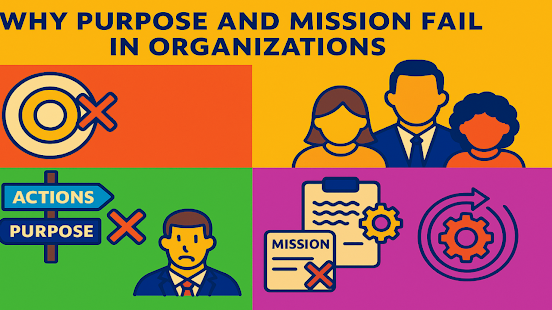Many organizations invest significant time and energy into crafting their purpose and mission statements, but over time, these guiding principles fail to have the intended impact. Purpose and mission are meant to inspire, align, and guide, but when not implemented effectively, they can quickly lose their power.
Here are key reasons why purpose and mission fail in organizations:
- Lack of Authenticity – When the purpose or mission feels disconnected from the organization’s actions or is created as a marketing tool rather than a true reflection of the company’s values, it loses credibility. Authenticity is key to ensuring the purpose resonates with both employees and customers.
- Top-Down Creation – Often, purpose and mission are created by leadership alone, without input from employees. This top-down approach can lead to disengagement. When employees don’t have a hand in creating the purpose, they may struggle to connect with it.
- Failure to Align Actions with Purpose – If the company’s actions don’t align with its stated purpose, employees will quickly notice the disconnect. A purpose must be reflected in everything the organization does—from strategic decisions to customer interactions.
- Overcomplication – Sometimes, companies try to create grand, complex mission statements that end up being difficult to remember or understand. A mission should be clear, concise, and easily relatable by everyone in the organization.
- Lack of Leadership Commitment – If leadership is not truly committed to the purpose and mission, it can easily fade into the background. Leaders must embody the purpose and mission in their everyday actions and decisions, and they must be role models for the rest of the organization.
- Not Evolving with Time – A static purpose or mission can become irrelevant as the business environment, market, or organizational needs evolve. A true mission evolves with time and remains aligned with changing circumstances and challenges.
How to Overcome These Challenges:
- Co-Create Purpose with Employees: Instead of just defining the purpose top-down, involve employees in the creation process. A co-created purpose leads to stronger ownership and alignment.
- Ensure Authenticity: Make sure your purpose and mission are deeply embedded in the company’s DNA and aligned with core values.
- Align Every Action: Ensure that the organization’s actions, decisions, and policies are aligned with its mission. Make the purpose a lens for decision-making.
- Keep It Simple: Your purpose and mission should be clear and concise, easily understood by everyone in the organization.
- Commit from the Top: Leadership must be unwavering in their commitment to the purpose and lead by example.
- Adapt and Evolve: Regularly review and adapt the mission and purpose to keep it relevant to the organization’s goals and challenges.
Purpose and mission are more than just words—they are the foundation of an organization’s culture and strategy. When purpose is co-created with employees, it fosters a deeper connection, greater alignment, and stronger commitment. How do you ensure your company’s mission stays relevant and meaningful? Let’s discuss!
#OrganizationalPurpose #Leadership #CompanyCulture #MissionDriven #BusinessGrowth #LeadershipDevelopment #PurposeAndMission #Strategy #EmployeeEngagement #AnilBahl #ELC

No comments:
Post a Comment